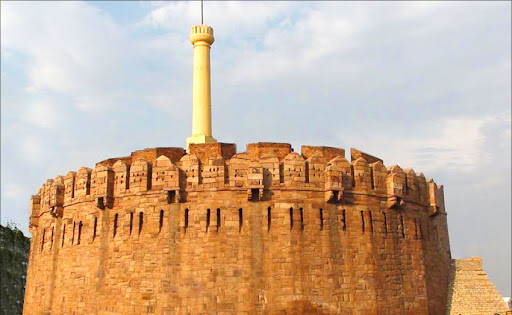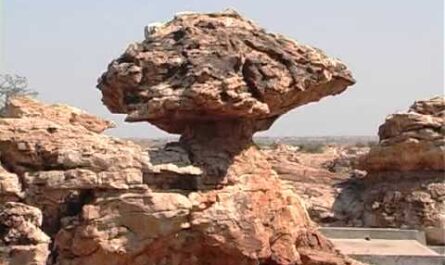Top Tourist Attractions in Kurnool
Kurnool is a city in Andhra Pradesh, India, and the state’s judicial capital. It was previously the capital of Andhra Pradesh. The city is commonly referred to as “Rayalaseema’s Gateway.” It also acts as the Kurnool district’s district headquarters. This district takes its name from Kurnool, the former capital of the Nawabs, the capital of Andhra Pradesh State from 1 October 1953 to 1 November 1956, and the district’s current seat. Kurnool is supposed to be originated from the word “Kandanavolu.”
Best Places to Visit in Kurnool
- Srisaliam Temple
- Mahanandi Temple
- Ahobilam Temple
- Mantralayam Temple
- Yaganti Temple
- Belum caves
- Rolla Padu Sanctuary
- Orvakallu Rock Gardens
- Kethavaram Rock Paintings
- Bramham Gari Matam-Banaganapalli
- Kondareddy Burzu Kurnool
- Achyutha Devarayala Buruzu
Srisailam
It is 180 kilometres from Kurnool and 210 kilometres from Hyderabad, with an elevation of nearly 1500 feet above sea level in a gorgeous natural setting in the northernmost portion of the Nallamalas hill range. Srisailam’s temple is an old and important site in South India. The presiding deity of the location is Brahmaramba Mallikarjuna Swamy, who is enshrined in natural stone formations in the shape of a lingam and is one of the twelve Jyotirlingams in the country. The temple was established in the 14th century, and the walls are etched with pictures of elephant hunting scenes and Lord Shiva in various forms. Apart from the main temple, other sights worth seeing include Sikhareswaram, the Gates of Heaven, Hatakeswaram, and PalaDhara – PanchaDhara, Sakshi Ganapathi, Sivaji Spurthikendra, Pathala Ganga, Chenchu Lakshmi Tribal Museum, and Rajeev Gandhi Wild Life Sanctuary.
Achyutha Devarayala Buruzu(Konda Reddy Buruzu):
Kondareddy Burzu Kurnool
Achyutha Devarayala Buruzu (Konda Reddy Buruzu) is located in the heart of Kurnool and is thought to have been built between 1529 and 1542 AD by Achyutha Devaraya, brother of Sri Krishnadevaraya, Raja of Vijayanagaram. It was part of the Kurnool fort and used as a jail. In this jail, one revolutionary, Konda Reddy, was martyred. Since then, the location has been known as KondaReddy Buruju.
Srisaliam Temple
It is 180 kilometres from Kurnool and 210 kilometres from Hyderabad, with an elevation of nearly 1500 feet above sea level in a gorgeous natural setting in the northernmost portion of the Nallamalas hill range. Srisailam’s temple is an old and important site in South India. The presiding deity of the location is Brahmaramba Mallikarjuna Swamy, who is enshrined in natural stone formations in the shape of a lingam and is one of the twelve Jyotirlingams in the country. The temple was established in the 14th century, and the walls are etched with pictures of elephant hunting scenes and Lord Shiva in various forms. Apart from the main temple, other sights worth seeing include Sikhareswaram, the Gates of Heaven, Hatakeswaram, and PalaDhara – PanchaDhara, Sakshi Ganapathi, Sivaji Spurthikendra, Pathala Ganga, Chenchu Lakshmi Tribal Museum, and Rajeev Gandhi Wild Life Sanctuary.
Mahanandi Temple
The Mahanandiswara temple in Mahanandi mandal is a well-known pilgrimage destination that goes back to the 7th century A.D. It is 14 kilometres from Nandyal and 80 kilometres from Kurnool. It is a picturesque site located to the east of the Nallamalas hill range in a natural setting of stunning beauty surrounded by dense forest. The crystal pure water that runs throughout the year from perennial springs is the most notable feature here. The Mahanandiswara festival is held in February and March. Throughout the year, pilgrims and tourists from all across India, notably South Indians, visit this site. Other locations worth seeing are Pushkarani, a pond with water so clean and pure that even a pin at the bottom can be seen, KodandaRamalayam, and Kameswari Devi temple.
Ahobilam Temple
It is a famous holy site of antiquity and is located 68 kilometres from Nandyal, 28 kilometres from Allagadda, and 160 kilometres from Kurnool.
Worship is conducted to Navanarasimha (the Nine Forms of Lord Narasimha) in higher Ahobilam, whereas Prahladavarada’s temple is located at lower Ahobilam, down the hill. The Brahmotsavam is held in the months of February and March, and it attracts a significant number of worshippers. Other places to visit include the Amruthavalli tavar temple, Sannidhi Pushkarini, and Bhashyakara Sannindi.
Mantralayam Temple
Mantralayam is located on the banks of the Tungabhadra River, 90 kilometres from Kurnool. Its significance stems from Madhva Saint Sri Raghavendra Swamy’s Jeevasamadhi. The Choultries and Sanskrit School are the main draws of these places, attracting thousands of devotees from South India, particularly Madhvas. The important visiting spots include Raghavendra Swamy Brindavan, the tomb that Swamy entered alive, Panchamuki Anjaneya Swamy Temple, and Venkateswara Swamy Temple.
Yaganti Temple
Yaganti is 11 kilometres away. It is located 90 kilometres from Kurnool and is surrounded by natural landscape with caverns and water falls. Uma Maheswara Swamy, also known as Yaganti Swamy, is the presiding deity. This god has the shape of a statue, and its tower is adorned with magnificent sculptures. The most impressive sight of this temple is the massive Nandi, which measures 15′ X 10′ X 8′. The Mahasivaratri Festival is celebrated here and draws a big crowd of Hindus.
Belum caves
Belum Caves are located near Belum village in Kurnool’s Kolimigundla mandal. The Caves are 110 kilometres from Kurnool through Banaganapalli. Belum Caverns, discovered in 1982, are the second biggest natural caves in the Indian Subcontinent after Meghalaya Caves. These underground caverns are placed on a level agricultural field and include three well-like chambers, with the central one serving as the cave’s primary entrance.
The cave is horizontal after a distance of 20 metres from the entrance and has a length of 3229 metres. Belum Caves, which are longer than Borra Caves in Vizag district, contain lengthy corridors, wide chambers, fresh water galleries, and syphons. Inside, there are landmarks such as “Simhadwaram,” “Kotilingalu,” “Manadapam,” and “Pathalaganga.” All of this gives Belum Caves a geographical and archaeological draw for people all over the world.
Rolla Padu Sanctuary:
The Rolla Padu Sanctuary is located in Midthur mandal, around 60 kilometres from Kurnool. Aside from a diverse range of birds and animals, this sanctuary is well-known for being one of the remaining refuges for the endangered Great Indian Bustard (Batta Meka Pitta), a hefty Ground Bird similar to a baby ostrich or peahen.
Orvakallu Rock Garden: A Magical Place – Amidst the Wonder of Nature:
Orvakallu is a one-of-a-kind adventure location. Andhra Pradesh Tourism has recognised the splendour of these formations and has created a 1000-acre park with the magnificent volcanic rock formations as the focal point. It’s also not too far from town. Drive 20 kilometres from Kurnool and you’ll come upon this site, which is directly on National Highway 18. The adventurer can traverse the serpentine routes here and indulge in nature’s untamed magnificence. Andhra Pradesh Tourism created these trekking trails to enhance the experience. The park is also a popular filming location.
Kethavaram Rock Paintings:
Paintings from the Paleolithic period were uncovered along a length of rocks at Orvakallu, and these sets of paintings have been dated down the years, from realistic depictions of huge deer by hunter gathers to symbolic people of the Iron Age, and handprints of more recent pilgrims. This is one of the world’s longest rock art series.
Bramham Gari Matam-Banaganapalli:
Banaganapalli is 85 kilometres from Kurnool. In this region, Veera Bramham is a well-known saint. He resided in this location and had “Kalagnanam” inscribed on palm leaves. Garimireddy Achamma has taken Veera Bramham as a pupil and provided him with refuge. In her home, he worked as a Gopala. Chintamani Matam and Nelamatam are well-known in this town, while Banaganapalli is well-known for its Mango Gardens.
Best Time to Visit in Kurnool
Banaganapalli is 85 kilometres from Kurnool. In this region, Veera Bramham is a well-known saint. He resided in this location and had “Kalagnanam” inscribed on palm leaves. Garimireddy Achamma has taken Veera Bramham as a pupil and provided him with refuge. In her home, he worked as a Gopala. Chintamani Matam and Nelamatam are well-known in this town, while Banaganapalli is well-known for its Mango Gardens.
How to Reach Kurnool
By Air
Kurnool is devoid of its own airport. The nearest airport is Hyderabad Airport, which is 213 kilometres away from Kurnool. It has flights to and from all of India’s main cities. Additionally, it has some international ties. You can hire cabs or utilise readily accessible state buses to travel farther distances.
By Rail
Kurnool does not have its own airport. Kurnool is 213 kilometres from Hyderabad Airport, which is the closest airport. Flights are available to and from all of India’s major cities. It also has some international connections. To go further distances, you can rent a cab or take use of the widely available state buses.
By Road
Kurnool has a good network of state as well as district roads. National Highway No.7 traverses through this city, connecting it with other parts of India. Places like Cuddapah, Anantapur, Chittoor and Hyderabad are well-connected by various state and private bus services. Private taxis can be hired from anywhere in the state to travel here.


